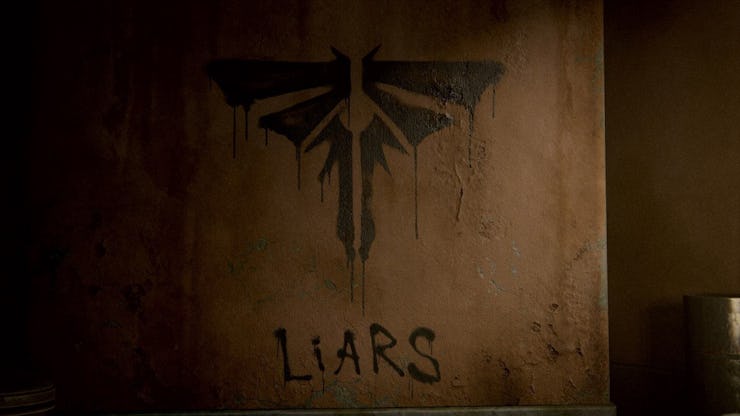Fireflies vs. FEDRA: Who should you trust in HBO’s The Last of Us?
The HBO show's 2 big groups, explained.

Who can you trust in a zombie apocalypse? From the very beginning, HBO’s The Last of Us presents two opposing forces: FEDRA (the military granted sweeping authoritarian powers amidst a zombie apocalypse) and the Fireflies (a rebel group attempting to overthrow them).
But who is good and who is bad in a world that’s rarely that simple? And, more importantly, who should Joel (Pedro Pascal) and Ellie (Bella Ramsey) trust in their adventures across the former united states? To find out, let’s dive into the video game that inspired The Last of Us.
What is FEDRA in The Last of Us?
Standing for Federal Disaster Response Agency, FEDRA is an approximation of the real-life Federal Emergency Management Agency (aka, FEMA) — if FEMA took over the entire country and declared martial law.
An old FEDRA sign in The Last of Us games.
In The Last of Us, FEDRA steps in after the “Cordyceps” outbreak leads to a zombie-like apocalypse. They are one of the last remaining departments of the U.S. government (along with the Department of Defense and the CDC).
In a coup, FEDRA takes control of the entire military and forces out other government officials. They then proceed to relocate the remaining U.S. population into special “Quarantine Zones” in major urban centers like Boston, Pittsburgh, and Seattle. Life in QZs is completely controlled by FEDRA and becomes increasingly authoritarian. As depicted in the HBO show, strict curfews are enforced (and in the game, civilians are prohibited from communicating with people in other Quarantine Zones). This leads to the rise of the Fireflies (more on that in a second).
In the video game, FEDRA serves as a minor antagonist since most of the game takes place outside of these QZs. It’s also worth noting that those enemies are typically soldiers and other drafted civilians, rather than actual FEDRA officials. The organization also has its own headquarters not located within one of the QZs.
Who are the Fireflies in The Last of Us?
Two people paint over some Fireflies graffiti in HBO’s The Last of Us.
The Fireflies were created by Marlene (played by Merle Dandridge on the show) in response to FEDRA’s actions. The Fireflies demand that FEDRA give up military rule and organize riots in the QZs. Their slogan, “Look for the light,” is often seen spraypainted in those cities. While loosely operating under a single name, different cells of the Fireflies often work on their own with little unifying leadership.
Are the Fireflies good or bad?
Spoilers ahead for the game and the HBO series!
In the game, the Fireflies are quickly revealed to be more bad than good (at least from Joel and Ellie’s perspective). The organization is often as brutal and violent as FEDRA, and just as oppressive in the QZs it manages to take over.
Besides fighting FEDRA, one of the Fireflies’ main goals is to find a cure for the infection. The group hopes that Ellie’s natural immunity will lead to a cure. However, at the end of the game, it’s revealed that this is only possible by killing Ellie. This doesn't bother the Fireflies, and Joel has to kill a bunch of them to save her.
So if the question is: should you trust the Fireflies or FEDRA? Then the answer is: neither of them.
Fireflies vs. FEDRA: Who wins?
When FEDRA and the Fireflies fight, everyone else loses.
If you’re wondering who wins between the two groups, the answer is once again: neither of them.
The Fireflies do manage to liberate most of the QZs from FEDRA. (When the game starts, Boston is the last remaining FEDRA holdout.) However, it rarely goes well, with those QZs either kicking out the Fireflies, descending into total chaos, or both. Despite all this, FEDRA remains a powerful force capable of dispatching military forces to pursue Joel and Ellie throughout the game.
After the events of The Last of Us video game, the Fireflies technically disband. But it’s suggested that the new factions may have eventually reformed later on.
This article was originally published on